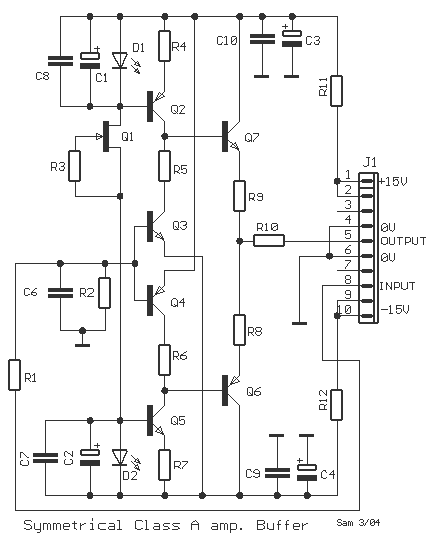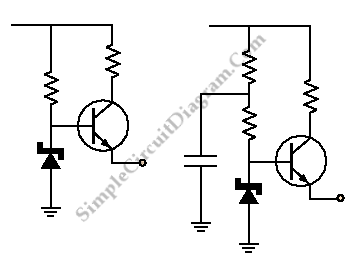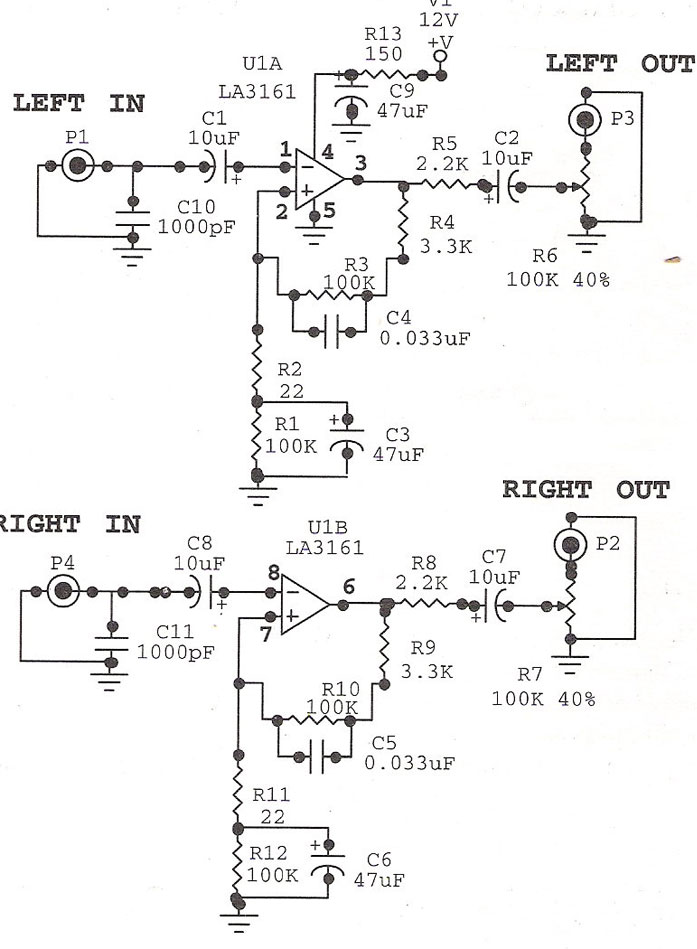
Modular Class A Buffer preamplifier

A unit which is often very useful, if we need to isolate, in sound circuits, two stage between them. Then we can use this circuit which has an amplified unit, which gain X1, we do not use total negative feedback, only local, with the result that distortion remains at a very low level. Matching must be done with great care to the types of transistors, resistor between them. There must also be thermal union between the transistors, as well as the diodes LED D1-2 with the transistor Q5 and Q2 respectively.
The described circuit functions as an isolation amplifier, specifically designed for sound applications where it is necessary to prevent interaction between two stages of amplification. This circuit employs a two-stage design, allowing for effective signal isolation while maintaining signal integrity.
The first stage of the circuit typically consists of a common-emitter amplifier configuration using bipolar junction transistors (BJTs). The gain in this stage is set to unity (X1), which means the output voltage will be approximately equal to the input voltage, preserving the original signal's amplitude. Local negative feedback is utilized rather than global feedback, which helps in minimizing distortion across the output while maintaining a straightforward signal path.
Transistor matching is crucial in this design, particularly in the context of thermal characteristics and gain parameters. The resistors connected between the transistors must be carefully selected to ensure that they provide the necessary biasing and stabilization for the circuit. Any mismatch can lead to increased distortion or thermal runaway conditions.
Thermal coupling is another essential aspect of this design. The transistors must be thermally coupled to each other to ensure that they operate within the same temperature range. This coupling helps mitigate differences in performance due to temperature variations, which can affect biasing and gain. Additionally, the circuit includes two light-emitting diodes (LEDs), designated as D1 and D2, which are thermally connected to transistors Q5 and Q2 respectively. This arrangement is likely used for visual indication or feedback in the circuit operation.
Overall, this isolation amplifier circuit is designed to achieve low distortion, stable performance, and effective thermal management, making it suitable for high-fidelity audio applications where signal integrity is paramount.A unit which is often very useful, if we need to isolate, in sound circuits, two stage between them. Then we can use this circuit which has an amplified unit, which gain X1, we do not use total negative feedback, only local, with the result that distortion remains at a very low level. Matching must be done with great care to the types of transistors, resistor between them. There must also be thermal union between the transistors, as well as the diodes LED D1-2 with the transistor Q5 and Q2 respectively.
🔗 External reference
The described circuit functions as an isolation amplifier, specifically designed for sound applications where it is necessary to prevent interaction between two stages of amplification. This circuit employs a two-stage design, allowing for effective signal isolation while maintaining signal integrity.
The first stage of the circuit typically consists of a common-emitter amplifier configuration using bipolar junction transistors (BJTs). The gain in this stage is set to unity (X1), which means the output voltage will be approximately equal to the input voltage, preserving the original signal's amplitude. Local negative feedback is utilized rather than global feedback, which helps in minimizing distortion across the output while maintaining a straightforward signal path.
Transistor matching is crucial in this design, particularly in the context of thermal characteristics and gain parameters. The resistors connected between the transistors must be carefully selected to ensure that they provide the necessary biasing and stabilization for the circuit. Any mismatch can lead to increased distortion or thermal runaway conditions.
Thermal coupling is another essential aspect of this design. The transistors must be thermally coupled to each other to ensure that they operate within the same temperature range. This coupling helps mitigate differences in performance due to temperature variations, which can affect biasing and gain. Additionally, the circuit includes two light-emitting diodes (LEDs), designated as D1 and D2, which are thermally connected to transistors Q5 and Q2 respectively. This arrangement is likely used for visual indication or feedback in the circuit operation.
Overall, this isolation amplifier circuit is designed to achieve low distortion, stable performance, and effective thermal management, making it suitable for high-fidelity audio applications where signal integrity is paramount.A unit which is often very useful, if we need to isolate, in sound circuits, two stage between them. Then we can use this circuit which has an amplified unit, which gain X1, we do not use total negative feedback, only local, with the result that distortion remains at a very low level. Matching must be done with great care to the types of transistors, resistor between them. There must also be thermal union between the transistors, as well as the diodes LED D1-2 with the transistor Q5 and Q2 respectively.
🔗 External reference





